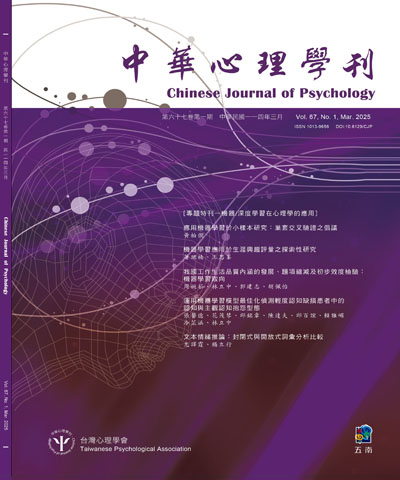
選擇卷期
- 期刊
視覺搜尋中,具有知覺群聚特性或顯眼的物體通常會獲取注意力,若目標位於顯眼的位置上亦應有益於搜尋。本實驗室先前的研究發現,在由許多小線段組成的搜尋畫面中,當目標與顯眼的干擾物重疊時,此干擾物若由彼此平行的線段組成(梯形干擾物)會促進搜尋,但若干擾物由彼此垂直的線段組成(蛇形干擾物)卻抑制搜尋。本研究欲探討促進和遮蔽效果與干擾物的知覺組織(相似性和連續性)和顯著性之間的關聯。實驗一將干擾物彎成曲線以去除干擾物組成內容的相似性,並打散背景線段的方位以降低干擾物的顯著性。結果發現蛇形干擾物仍產生 遮蔽效果,但是梯形干擾物若在異質背景就失去其促進效果。實驗二進一步操弄蛇形曲線干擾物在異質背景中的旁側線段的方位(正交、平行與隨機),測試干擾物本身的顯眼程度是否會調控共線遮蔽效果的大小。結果發現,當蛇形干擾物旁側線段為正交方位時最顯眼,但是三種旁側情況皆有遮蔽效果且遮蔽效果的大小與干擾物顯眼程度無關。因此知覺組織連續性是共線遮蔽效果的充分條件,顯著性與相似性與共線遮蔽效果無關。本研究的結果可以應用在偽裝或擬態的設計上。
- 期刊
個體所呈現的每日作息節律,可依其睡眠時間偏好被區分為不同的「時型」(chronotype)。本研究將Horne與Östberg於1976年發展且為現今最為廣用之時型測量工具─日夜作息習慣量表(Owl and Lark Questionnaire,或較廣為人知的名稱Horne and Ostberg Morningness-Eveningness Questionnaire)翻譯為中文,並以紙本版施測於大學生(18 ~ 28歲),獲得Cronbach's α係數.70(N = 213)及間隔一個月的再測信度.71(N = 28)。另也發展該量表之網路填寫版本並擴大施測年齡層(18 ~ 36歲)及社會背景,獲得Cronbach's α係數.75(N = 660)及間隔120 ~ 339天的再測信度.61(n = 24)。兩組的日夜作息習慣量表總分與就寢時間及起床時間皆呈現顯著負相關(-.40 ~ -.60),日夜作息習慣量表總分越高即越偏向白日型(morning type)者,就寢及起床時間越早。夜貓型(evening type)者的週間週末起床時間差異最大,且其週間睡眠長度雖未和其他時型者呈現顯著差異,其週末睡眠長度卻顯著較長。紙本版的日夜作息習慣量表總分和年齡及白日睏睡度的關係未達顯著,但網路版則顯示日夜作息習慣量表總分越高,則年齡越長及白日睏睡度越低。紙本與網路版的日夜作息習慣量表總分則都未呈現顯著的性別差異。整體而言,本研究結果支持中文版日夜作息習慣量表,無論是紙本標準版或是網路版本,皆為具良好信效度之時型評估工具。
- 期刊
National Taiwan University, formerly Taihoku Teikoku Daigaku (or Taihoku Imperial University), has one of the largest collections of historical instruments in the field of se nsory psychology. A total of one hundred-and-fifty instruments were acquired by Prof. Iinuma, founder and first professor of the Department of Psychology, from Germany between 1930 ~ 1932. Fifty-five instruments have survived. Here we describe 26 of the more important instruments by tracing them to the manufacturer's manuals (e.g., the "Zimmermann lists"), early publications, the World Wide Web, and our own understanding of the mechanical principles that were used in making them. Instruments are grouped according to their use for measurement in the domains of vision, hearing, to uch, time control, performance, and recording. The art of building equipment for experimental research in sensory psychology was well established in Germany during the years 1875 ~ 1914, when companies in Leipzig, Berlin, and Göttingen produced apparatuses not just for German laboratories, but also for laboratories in Czechoslowakia, Serbia, the Netherlands, and even in Japan and the United States. In time, some of these countries started producing their own instruments. For example, the Large Time Sense Apparatus at National Taiwan University (labeled D1 in this manuscript) was not imported from E. Zimmermann Co., but was built by Yamakoshi Seisakusho in Japan in 1945. The impact of these companies onto the history of psychology cannot be overestimated. Psychology was originally part of the Philosophy Department, but became independent thanks to the development of fine-mechanical instruments, which enabled accurate measurement and quantification of empirical results. This so-called "new" psychology became an experimental science akin to physics and physiology, when apparatuses typically made from steel and brass, became available for the objective investigation of the senses. The goal of studying those old instruments nowadays is threefold: (1) to contribute to the history of scientific instrumentation; (2) to raise awareness in today's students of how early researchers, after conceiving an idea for an experiment, often waited for a long time for an appropriate apparatus to be built; (3) to inspire students to think about the intimate relationship between scientific ideas, available apparatus, and experiments performed. The loss of workshops in today's psychological institutes is deplorable, as computers cannot fully compensate for the flexibility of a fully equipped laboratory.

